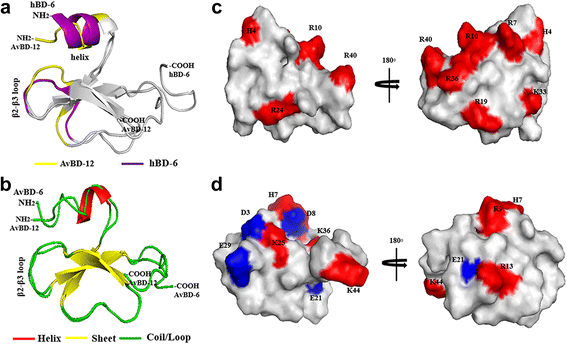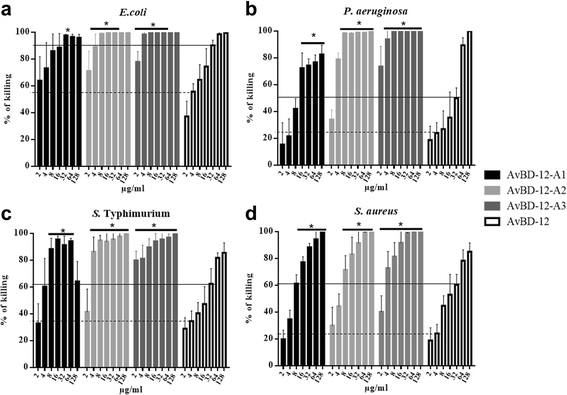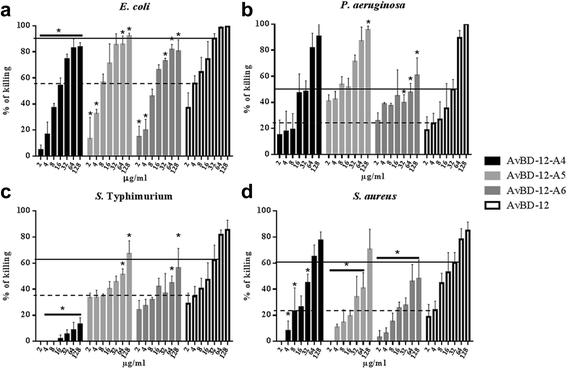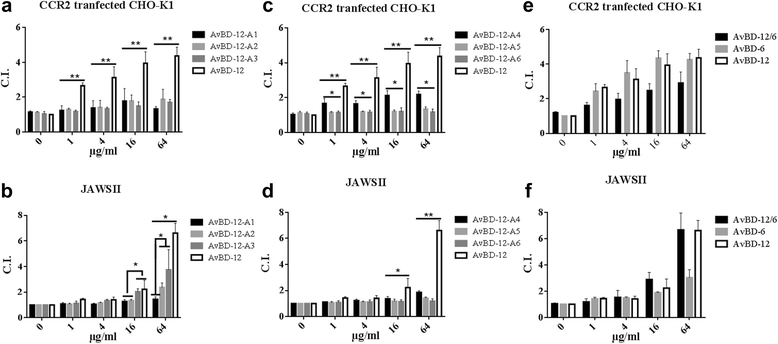Novel synthetic analogues of avian β-defensin-12: the role of charge, hydrophobicity, and disulfide bridges in biological functions
- PMID: 28231771
- PMCID: PMC5324278
- DOI: 10.1186/s12866-017-0959-9
Novel synthetic analogues of avian β-defensin-12: the role of charge, hydrophobicity, and disulfide bridges in biological functions
Abstract
Background: Avian β-defensins (AvBD) possess broad-spectrum antimicrobial, LPS neutralizing and chemotactic properties. AvBD-12 is a chemoattractant for avian immune cells and mammalian dendritic cells (JAWSII) - a unique feature that is relevant to the applications of AvBDs as chemotherapeutic agents in mammalian hosts. To identify the structural components essential to various biological functions, we have designed and evaluated seven AvBD analogues.
Results: In the first group of analogues, the three conserved disulfide bridges were eliminated by replacing cysteines with alanine and serine residues, peptide hydrophobicity and charge were increased by changing negatively charged amino acid residues to hydrophobic (AvBD-12A1) or positively charged residues (AvBD-12A2 and AvBD-12A3). All three analogues in this group showed improved antimicrobial activity, though AvBD-12A3, with a net positive charge of +9, hydrophobicity of 40% and a predicted CCR2 binding domain, was the most potent antimicrobial peptide. AvBD-12A3 also retained more than 50% of wild type chemotactic activity. In the second group of analogues (AvBD-12A4 to AvBD-12A6), one to three disulfide bridges were removed via substitution of cysteines with isosteric amino acids. Their antimicrobial activity was compromised and chemotactic activity abolished. The third type of analogue was a hybrid that had the backbone of AvBD-12 and positively charged amino acid residues AvBD-6. The antimicrobial and chemotactic activities of the hybrid resembled that of AvBD-6 and AvBD-12, respectively.
Conclusions: While the net positive charge and charge distribution have a dominating effect on the antimicrobial potency of AvBDs, the three conserved disulfide bridges are essential to the chemotactic property and the maximum antimicrobial activity. Analogue AvBD-12A3 with a high net positive charge, a moderate degree of hydrophobicity and a CCR2-binding domain can serve as a template for the design of novel antimicrobial peptides with chemotactic property and salt resistance.
Keywords: Antimicrobial activity; Avian β-defensin analogues; Chemotactic activity; Disulfide bridges; Hydrophobicity; Net positive charge.
Figures










Similar articles
-
Structure-function analysis of Avian β-defensin-6 and β-defensin-12: role of charge and disulfide bridges.BMC Microbiol. 2016 Sep 9;16(1):210. doi: 10.1186/s12866-016-0828-y. BMC Microbiol. 2016. PMID: 27613063 Free PMC article.
-
Beta-defensin derived cationic antimicrobial peptides with potent killing activity against gram negative and gram positive bacteria.BMC Microbiol. 2018 Jun 5;18(1):54. doi: 10.1186/s12866-018-1190-z. BMC Microbiol. 2018. PMID: 29871599 Free PMC article.
-
Structure-activity relation of human beta-defensin 3: influence of disulfide bonds and cysteine substitution on antimicrobial activity and cytotoxicity.Biochemistry. 2005 Jul 19;44(28):9804-16. doi: 10.1021/bi050272k. Biochemistry. 2005. PMID: 16008365
-
Synthesis and structure-activity relationship of beta-defensins, multi-functional peptides of the immune system.J Pept Sci. 2006 Apr;12(4):243-57. doi: 10.1002/psc.749. J Pept Sci. 2006. PMID: 16491514 Review.
-
Disulfide Bridges in Defensins.Curr Top Med Chem. 2015;16(2):206-19. doi: 10.2174/1568026615666150701115911. Curr Top Med Chem. 2015. PMID: 26126908 Review.
Cited by
-
Identification of prognostic hub genes and therapeutic targets for selenium deficiency in chicks model through transcriptome profiling.Sci Rep. 2023 May 29;13(1):8695. doi: 10.1038/s41598-023-34955-6. Sci Rep. 2023. PMID: 37248251 Free PMC article.
-
Mycobacterium tuberculosis cell-wall and antimicrobial peptides: a mission impossible?Front Immunol. 2023 May 17;14:1194923. doi: 10.3389/fimmu.2023.1194923. eCollection 2023. Front Immunol. 2023. PMID: 37266428 Free PMC article. Review.
-
Overexpressing ovotransferrin and avian β-defensin-3 improves antimicrobial capacity of chickens and poultry products.Transgenic Res. 2019 Feb;28(1):51-76. doi: 10.1007/s11248-018-0101-2. Epub 2018 Oct 29. Transgenic Res. 2019. PMID: 30374651
-
Antimicrobial Peptides: From Design to Clinical Application.Antibiotics (Basel). 2022 Mar 6;11(3):349. doi: 10.3390/antibiotics11030349. Antibiotics (Basel). 2022. PMID: 35326812 Free PMC article. Review.
-
Antimicrobial efficacy and toxicity of novel CAMPs against P. aeruginosa infection in a murine skin wound infection model.BMC Microbiol. 2019 Dec 16;19(1):293. doi: 10.1186/s12866-019-1657-6. BMC Microbiol. 2019. PMID: 31842727 Free PMC article.
References
MeSH terms
Substances
LinkOut - more resources
Full Text Sources
Other Literature Sources

